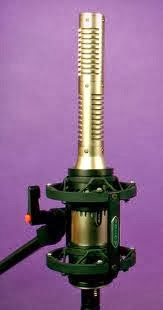This design of audio transducer is the most common in use today - every variation from "spy" mics and tiny mics in the top of laptop computer screens to large versions, such as the one on the right, found in recording studios and sometimes on stage.
Purchase prices can vary from less than $20.00 to over $5,000.00 per unit. Some can be hand-held, for vocal work; others require isolating mounts because of their sensitivity to being handled. Most of the cheaper models use a battery, usually a "AA" 1.5V cell, fitted in the body of the microphone. All condenser ( or capacitor ) microphones require a power supply to work. Studio types, such as the one above, are provided with power from the mixing console or preamplifier to which they are connected. This is called
phantom power, and is set at 48Volts. The power supply for the mic. and the signal from the mic. use the same 3-conductor cable: quite an ingenious arrangement!
How do they work?
This is a partly disassembled studio condenser microphone. The top two pieces are the head basket, which protects the capsule ( the transducer part ) and the main body, which houses the electronics and the mount for the cable socket. The ring at the bottom of the picture screws the whole assembly firmly together.
At the right, and below, are two types of large diameter ( 32 - 35mm diameter total capsule diameter ) assemblies. Small diameter capsules would be 12mm or less.
Large diameter capsules are found in side-address microphone designs, such as the illustration at the top of this page - the mic. is pointed sideways towards the sound source.
Small diameter capsules are found in end-address microphone designs - the mic. is pointed end-on towards the sound source: think of a hand-held vocal mic.

The diagram on the right shows the basic design principle, edge-on view, of a condenser mic.
Sound hits the tight mylar (plastic) diaphragm, which is rendered conductive by spattering with a very thin coating of metal, usually gold. This diaphragm is typically only 5 or 6 microns thick, and is
very responsive to the slightest sound: wide frequency response and great detail are features of this type of microphone. The movement of the capsule diaphragm produces changes in the electrical capacitance between the diaphragm and its associated backplate, which is a much heavier, perfectly stiff disc of brass (usually), through which an array of small holes has been drilled.to allow free air movement. The microphone electronics convert this fluctuating capacitance into a voltage and current which can be amplified for use in a recorder or mixer.
Usually the electronics are "solid state", as in the above mic. interior illustration, but some of the classic and even modern designs use a low-noise audio valve (tube), with its own special power supply unit. This type of mic. can be quite expensive, but very sweet-sounding!

I wouldn't mind one of these in my collection!
Or one of these! Maybe two would do.
Ah well, I can dream.......
Until next time, when we'll discuss
ribbon microphones.
 Several single-unit stereo mics have been produced using this arrangement. Here are two available from Royer Labs:
Several single-unit stereo mics have been produced using this arrangement. Here are two available from Royer Labs:

















